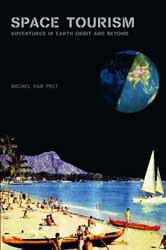
Space tourism seems as obtainable to us as the sun was to Icarus. We struggle to maintain and inhabit a man made structure in the safety of low Earth orbit. Yet, we read about hotels that will allow honeymooners to gaze at the sun setting every 90 minutes. This may be a bit of a stretch, but space tourism can solidly generate revenue for some entrepreneur. As Van Pelt notes, two people have already paid significant amounts, $20 million each, to visit space. Further, as the attraction would easily better any other on planet Earth, all that’s needed is a price low enough. With this, hundreds of people each year would spend their annual vacations in orbit. It is an extreme engineering challenge if there ever was one. Still, from Van Pelt’s perspective, it’s quite obtainable.
Through the book, Van Pelt discusses the technical issues of space flight and pleasant issues of leisure time in space. In a neutral, analytical view, he considers technical issues, starting with the history of space activities, the progressive development of launch vehicles, existing state of the art capabilities and the steps needed to enable the space tourism industry. Practicalities like radiation dosimetres, pressure suits to counter g forces, pre-flight training and group interactions also get attention. These and other technical details are faithfully extended from current or historically established technology. However, launcher reusability is favoured without much supporting justification. Also, some of the later discussion about warp drives, transporters and faster than light travel seem a little out of place and add an incredulous tone to an otherwise rational and even presentation.
Van Pelt has much more fun with the leisure time activities. Using a first person perspective, he places the reader on a three day vacation to an orbiting hotel. The novelty of training, safety lessons and equipment fit-out comes through like any tourist getting ready to embark on some adventurous voyage to the big unknown. Continual comparisons to today’s commercial aeroplane flights enhance the nearness of this opportunity. Further chapters on the launch, ascent and commencement of microgravity quickly distance this trip from any commercial flight. The prose really puts the reader’s feet in the shoes of the starry eyed guest. The descent and landing give the pleasant denouement that would leave the space flyer, and presumably the reader, earnestly desiring another flight. Van Pelt also forays into predicting voyage highlights by imagining sports, games, trysts, and dancing in the realm of microgravity. He ably amplifies how common activities can take on exhilarating dimensions in the confines of a space hotel or on distant surfaces such as the 1/6’th gravity of the moon. There certainly shouldn’t be any lack of fun should his views come to pass.
To aid the reader, the two aspects of the book, the technical and first person view, come in their own chapters. Each follows along logically from the predecessor. For example, first the technical chapter discusses launch vehicles. Then, the first person view places the reader in the eyes of a person as they are launched. Despite these two aspects, the prose remains complimentary, the technical part not being too dry nor the first person view being too qualitative.
As well, the imagination and optimism shown in this book makes for an enjoyable and quick read. Quotes from science fiction writers shows how reality keeps catching up to the earlier imagination of writers from many years ago. Sometimes the optimism gets a bit much though. Van Pelt would have us believe that only a few different decisions at various stages in the United States’ space program would have had people on Mars by now. Also, the discussions about travelling to Mars and further distant planets or stars again raise incredulity rather than support the perceived industry. To build credence and optimism, these parts of the book should have been balanced with more details on means and methods of constructing the infrastructure.
Reality keeps catching up with science fiction. Scientists labour in labs while engineers construct in the field in order to bring the future a little closer to today. However, even they will need to rest and recharge. Michel Van Pelt describes the perfect travel location for recharging in his book, Space Tourism and shows what we need to get there and what may happen once we arrive.
Read more reviews online or purchase a copy from Amazon.com.
Review by Mark Mortimer.
